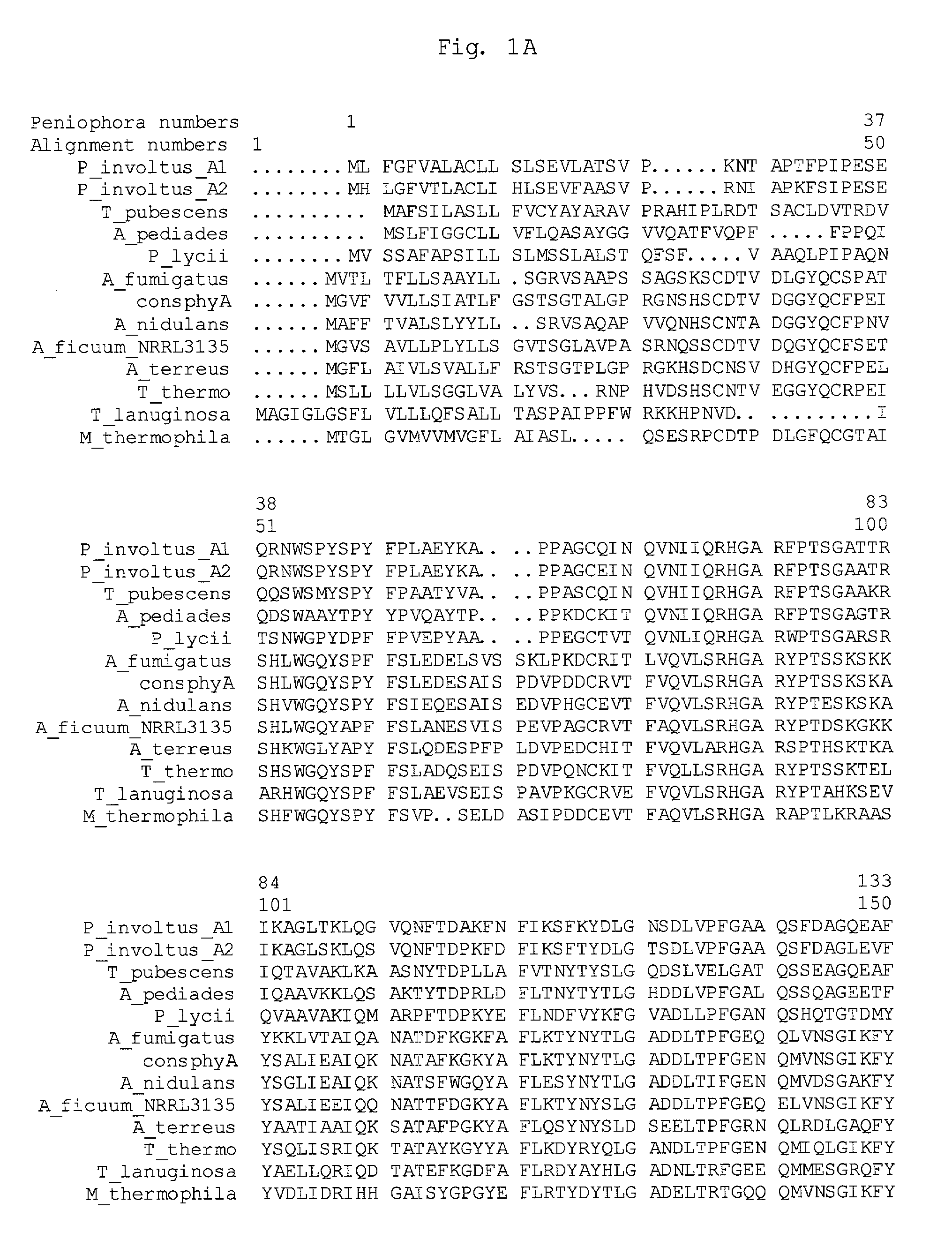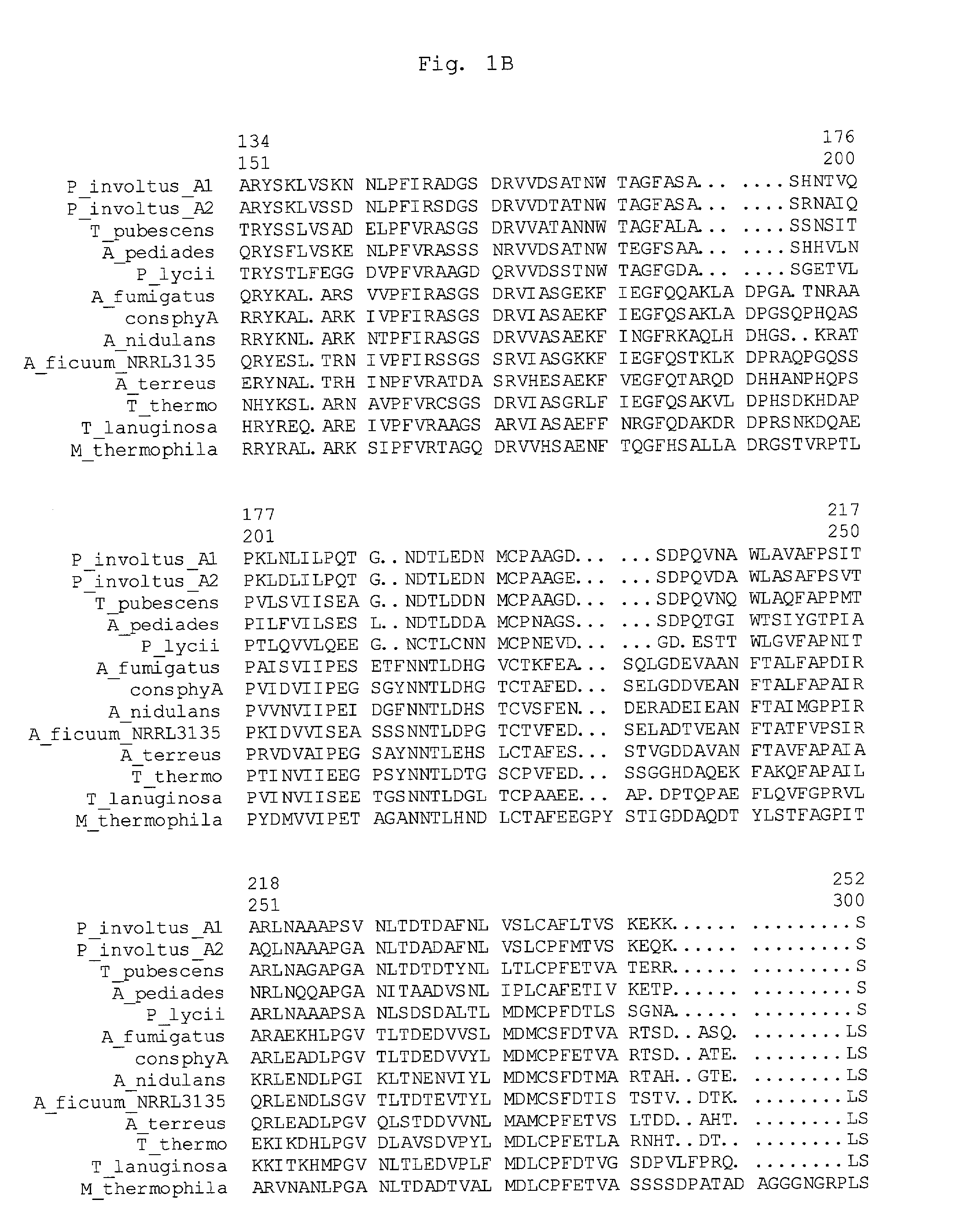Phytase variants
a technology of phytase and variants, which is applied in the field of variants of phytases, can solve the problems of large growth and unsatisfactory phosphate pollution of the environmen
- Summary
- Abstract
- Description
- Claims
- Application Information
AI Technical Summary
Benefits of technology
Problems solved by technology
Method used
Image
Examples
example 1
[0258] Phytase Activity Assay (FYT)
[0259] Phytase activity can be measured using the following assay: 10 microliter diluted enzyme samples (diluted in 0.1 M sodium acetate, 0.01 % Tween20, pH 5.5) are added into 250 .mu.l 5 mM sodium phytate (Sigma) in 0.1 M sodium acetate, 0.01 % Tween20, pH 5.5 (pH adjusted after dissolving the sodium phytate; the substrate is preheated) and incubated for 30 minutes at 37.degree. C. The reaction is stopped by adding 250 microliters 10% TCA and free phosphate is measured by adding 500 .mu.l 7.3 g FeSO.sub.4 in 100 ml molybdate reagent (2.5 g (NH.sub.4).sub.6Mo.sub.70.sub.24. 4H.sub.20 in 8 ml H.sub.2SO.sub.4 diluted to 250 ml). The absorbance at 750 nm is measured on 200 microliter samples in 96 well microtiter plates. Substrate and enzyme blanks are included. A phosphate standard curve is also included (0-2 mM phosphate). 1 FYT equals the amount of enzyme that releases 1 .mu.mol phosphate / min at the given conditions.
example 2
[0260] Test for Specific Activity
[0261] The specific activity can be determined as follows:
[0262] A highly purified sample of the phytase is used (the purity is checked beforehand on an SDS poly acryl amide gel showing the presence of only one component).
[0263] The protein concentration in the phytase sample is determined by amino acid analysis as follows: An aliquot of the phytase sample is hydrolyzed in 6 N HCl, 0.1% phenol for 16 h at 110.degree. C. in an evacuated glass tube. The resulting amino acids are quantified using an Applied Biosystems 420A amino acid analysis system operated according to the manufacturers instructions. From the amounts of the amino acids the total mass--and thus also the concentration--of protein in the hydrolyzed aliquot can be calculated.
[0264] The activity is determined in the units of FYT. One FYT equals the amount of enzyme that liberates 1 micromol inorganic phosphate from phytate (5 mM phytate) per minute at pH 5.5, 37.degree. C.; assay described...
example 3
[0266] Test for Temperature and pH Activity and Stability
[0267] Temperature and pH activity and stability can be determined as follows:
[0268] Temperature profiles (i.e. temperature activity relationship) by running the FYT assay of Example 1 at various temperatures (preheating the substrate).
[0269] Temperature stability by pre-incubating the phytase in 0.1 M sodium phosphate, pH 5.5 at various temperatures before measuring the residual activity.
[0270] The pH-stability by incubating the enzyme at pH 3 (25 mM glycine-HCl), pH 4-5 (25 mM sodium acetate), pH 6 (25 mM MES), pH 7-9 (25 mM Tris-HCl) for 1 hour at 40.degree. C., before measuring the residual activity.
[0271] The pH-profiles (i.e. pH activity relationship) by running the assay at the various pH using the same buffer-systems (50 mM, pH re-adjusted when dissolving the substrate).
PUM
| Property | Measurement | Unit |
|---|---|---|
| Temperature | aaaaa | aaaaa |
| Time | aaaaa | aaaaa |
| Mass | aaaaa | aaaaa |
Abstract
Description
Claims
Application Information
 Login to View More
Login to View More - R&D
- Intellectual Property
- Life Sciences
- Materials
- Tech Scout
- Unparalleled Data Quality
- Higher Quality Content
- 60% Fewer Hallucinations
Browse by: Latest US Patents, China's latest patents, Technical Efficacy Thesaurus, Application Domain, Technology Topic, Popular Technical Reports.
© 2025 PatSnap. All rights reserved.Legal|Privacy policy|Modern Slavery Act Transparency Statement|Sitemap|About US| Contact US: help@patsnap.com



